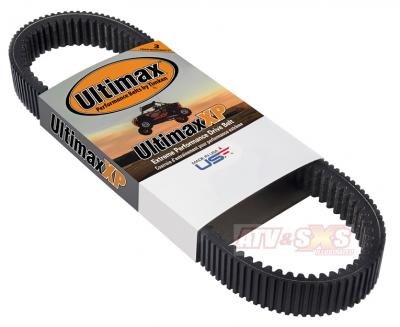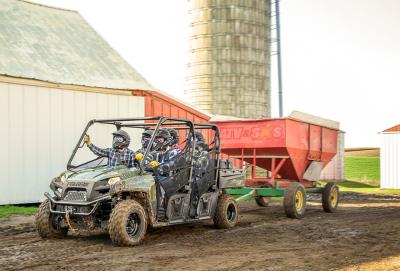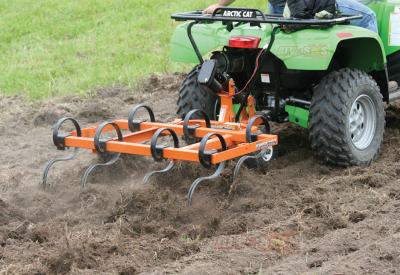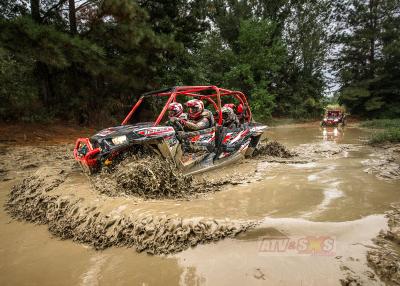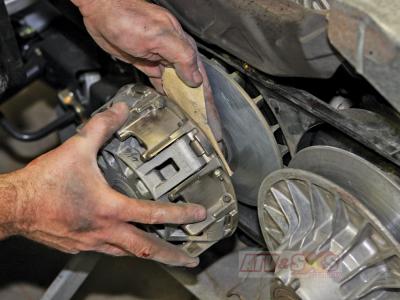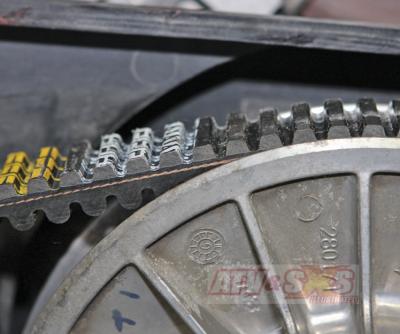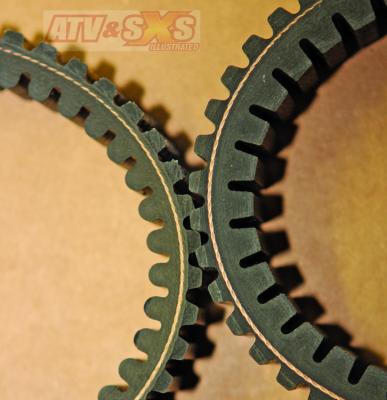Sooner or later you’re going to change a belt on your ATV or UTV. While both have practically identical engines, because of more than twice their overall weight and much higher towing and load carrying capabilities, a UTV drive train often bears loads that are several times what an ATV would see. On every brand but Honda all of that load is transferred through a belt. Your machines CVT (Continuously Variable Transmission) is the weak link in the system. Choosing the best belt for performance and durability has often been little more than a guess and the flip of a coin. The Ultimax®XP CVT Belt by Timken takes all the guess work out of your choice and it even comes with a guarantee!
BELT BASICS
In the business, they call CVT belts “Power Transmission Products” and Timken has an entire division devoted to belt design and manufacturing. Whether it runs on sand or snow they’ve almost certainly got a belt for it. While there are many companies that can produce a CVT belt, the trick is having the experience and resources to produce a belt that will survive the rigors of real-world abuse. That means endless testing of everything from cord performance, to crack resistance, and flex life. There is no part of the Ultimax CVT belts that is not fully tested in both lab and real world situations. Whatever crazy, maximum load tests your slightly off-center riding buddy dreamed up, it’s likely a testing engineer at Timken Belts has already thought of it as well.
The base components of most CVT belts are similar, consisting of a rubber compound surrounding an aramid (Kevlar) cord. The differences are in the details of how the fiber cords are treated, and the development of engineered rubber polymers that are heat and wear resistant. It’s extremely important that the fiber cord you can see on the side of the belt distributes stress evenly. A belts strength comes from this cord and it does the work of transmitting power. The job of the rubber is to grip the clutch faces and hold the cord in place. Important details of the Ultimax®XP CVT belts are:
-
Severe duty belt engineered for extreme performance
-
Engineered to handle heat, load and abuse while retaining flexibility and durability
-
Made with strong, stable aramid cord for superior resistance to shock loads
-
Constructed with fiber-reinforced advanced polymer compounds that work best for each specific application. Not a generic application product.
-
Purpose-built to handle the unique demands of harsh, powersports CVT environments - high loads and mud, heat, and grit.
-
3-year warranty!
-
Made in the U.S.A.
BELTS GONE BAD – WHEN TO REPLACE YOUR BELT
There are two sure signs your belt has gone bad. The first is a whiff of burnt rubber, often causing the driver and any passengers to pause and consider the source, and possible end game scenarios. A second later the answer is usually forthcoming, with the immediate clunk-clunk-clunk from somewhere underneath a soon to be (hopefully easily) removed CVT cover. Once inside, you’ll find what looks for all purposes to be a rubber mouse nest, with cords and shredded rubber bits wrapped around CVT clutches, and clogging air ducts. It’s a mess, and there will often be belt bits scattered across the engine and skid plate as well. Remove all of it and discard appropriately. Luckily, there is a way to avoid this problem.
-
KEEP YOUR CVT CLEAN - If you ride in lots of mud, dust, or water, take the cover off and blow out the entire area with compressed air.
-
INSPECT YOUR BELT - Take your belt off and look for broken cords or cracks in the rubber starting at the roots of the cogs. Also, look at the sidewall for any discolored area. That is likely “spin burn”. This is from excessive heat in one area.
-
CHECK FOR WEAR - Check the deflection of the belt, and follow your machines OEM specs for belt deflection. Worn edges mean the belt is not fully riding up the pulley faces, and you are throwing away performance. You can sometimes feel worn or burned spots as a vibration. If one side of your belt is noticeably more worn than the opposite side, you could have misaligned clutches. They need to pull in a straight line.
-
USE LOW GEAR - Use LOW gear for pulling loads, large hill climbs, rock crawling, or any slow riding. This keeps your engine revving at higher RPMS, and your belts fully engaged on the clutch faces.
-
CHECK CLUTCH WEIGHTS for WEAR OR NOTCHES.. A sharp eye can catch potential problems early.
When you have to change a belt, take note of the direction it came off your machine. There is usually a direction arrow, and you’ll need to install it in the same direction. Also, lightly sand any built up rubber off clutch faces, and then wipe clean, but DO NOT use harsh chemicals. Emory cloth works great for this. Never use a belt dressing or solvent on a belt. Finally, use the proper CVT tool and DO NOT stretch your belt over the pulleys, and DO NOT twist your belt inside/out. This is a sure way to break down some of the cord fibers, and you’ll quickly find yourself doing all of this again.
BELT UPGRADE
Heat and dirt are your CVT systems worst enemies, but they’re the norm in the world of ATVs and Side x Sides. With a little care your belt can last a very long time. When it comes time for a replacement, CVT belts are definitely one of those areas where brand matters, and the Ultimax®XP CVT belts provide a trusted, long term solution to your problem. Combine a premium quality belt with their 3-year warranty and you’ve got 3 years of worry free riding. It’s a no-brainer!
Find the correct Ultimax®XP belt for your machine with this handy “belt finder” tool at: www.ultimaxbelts.com/belt-finder


